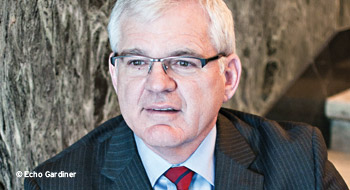

When Bill Kyle reflects on a career that has spanned more than 30 years, one thing that stands out is how the group insurance landscape has changed through consolidation.
From the mid-1990s through the early 2000s, the trust companies that had been significant players in the group retirement market left the industry, and many long-established insurance companies disappeared through mergers and acquisitions.
Kyle, executive vice-president, wealth management, with Great-West Life, has been at the forefront of a significant portion of this activity, helping to lead the integration of the group benefits businesses at London Life and Prudential of America, then later, between Great-West Life, London Life and Canada Life and, finally, integrating Merrill Lynch, Aim Trimark and Fidelity into Great-West Life.
“Those have been very challenging businesses to bring together in a way that makes sense for clients and to ensure you’re providing good service throughout the process,” says Kyle. His ability to help employees deal with uncertainty surrounding these organizational changes, and to help them understand their place in the organization going forward, has helped him successfully steer teams through the process. It’s a demanding and difficult task, but one that bears fruit in the end.
“As I travel across the country and meet with people in our organization, it’s terrific to see people who’ve come from these different companies working together as one team.”
All the change has taught Kyle a valuable lesson: people who believe in a common goal will work tirelessly to achieve it. “How much can be accomplished in very short time frames is surprising and gratifying to see.”
Kyle witnessed that again in the mid-2000s while working toward another industry-shaping goal—the development of the Capital Accumulation Plan Guidelines. The regulators leading the process, he says, did a great job of putting aside any preconceived notions and allowing all stakeholders to have a voice. As a result of the diversity of voices, the resulting guidelines were more principle-based than prescriptive, “which I think has allowed for the competitive nature of the business to drive all the changes that we’ve seen since the guidelines came in, in terms of how best to serve members.”
But Kyle says there’s more work to be done to combat the inertia that keeps employees from accumulating sufficient savings in their employer-sponsored plan.
“If I look back to when I was 23 years old and coming out of university, the last thing I wanted to hear was that I had to contribute 5% of my pay to a pension plan. But today, I feel pretty good about the fact I was forced to do that. You need to join a plan when you’re young and make meaningful contributions.”
As Kyle moves toward his own retirement, he hopes his post-work years will afford him chances to give back some of the knowledge he’s picked up throughout his career—ideally, through volunteering with an industry organization. And he wants to continue to pick up new skills and knowledge. “No matter how much I learn, it tends to just highlight how much more I need to learn.”
But he’s also looking forward to slowing down, to spend more time with his family—Kyle married his high school sweetheart, and the couple has a daughter who works in the industry and a son currently in university—and enjoy some of the simpler things in life.
“Having time to spend over coffee and a newspaper to start the day would be a very good thing.”
Neil Faba is associate editor of Benefits Canada. neil.faba@rci.rogers.com
